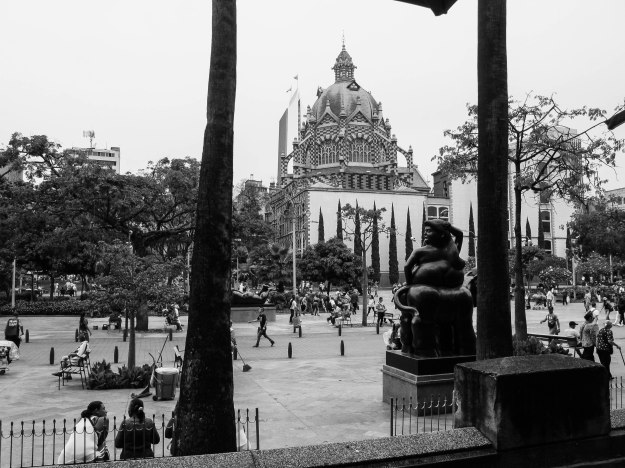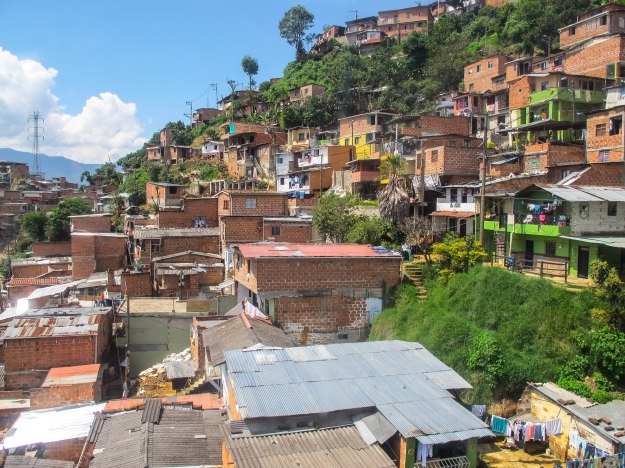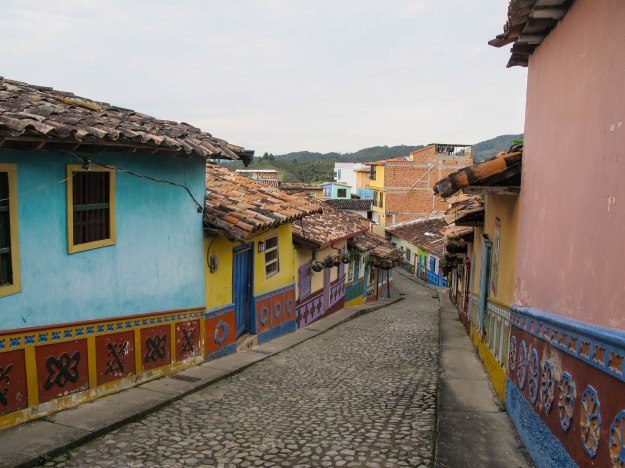
Live on an island long enough, and you begin to plan your vacation time around an escape to the nearest big city. It’s one of the only ways to combat island fever. The biggest city around this particular island is Caracas, Venezuela. It is not a city to travel to nowadays since it has been at the top of the list of most dangerous cities in the world for the past few years. Talk to anyone who has been here long enough, and they will tell you that Venezuela was once a vacation destination for Aruban residents. Back then, Colombia was the country to avoid. Time has a way of turning things around. After enough time passes in Latin America, the list of dangerous places changes: cities move up or down the list or fall off it all together as drug cartels are dismantled or dictators dissolve democracies to swallow a country whole. Nowadays, Medellín, once the most dangerous city in the world for most of my youth, is a popular choice for nearby places to vacation when you live in the South Caribbean Sea. And so Isabel and I decided to flee island fever with a trip to Medellín over Spring Break.
We started scouting out cheap tickets for Colombia back in January and found a roundtrip for $212 from Aruba to Medellín via Valencia, Venezuela, on Avior Airlines. Avior is one of several Venezuelan airlines that flies in and out of Aruba. Go to the non-U.S. side of the airport here, and you will see one ticket booth after another selling flights to nearby South American countries. The prices vary from counter to counter as you inquire about airline tickets by speaking through aluminum grills to representatives behind glass windows. A flight on a Colombian airline will cost you twice the price of one on a Venezuelan airline. Needless to say, what you save in money will be paid for with a spike in blood pressure and some beads of perspiration across your forehead while you wait in a crowded room without air conditioning for your connecting flight in Venezuela.
We waited in Valencia for about two hours for the connecting flight from Aruba to Medellín. The country’s instability outside could be felt inside the small building we were shuffled into shortly after our flight landed, a place that felt more like a bus station than an airport. As we surveyed the scene outside the window, we could see three planes in the near distance lined up in the order of what we assumed to be final destinations: Bogotá, Medellín, and Panama City. But it was hard to be sure of anything since there wasn’t any flight information posted about departure cities and times, and we found only one digital clock that was forever stuck at 4:12—a metaphor perhaps for the country. According to my phone, the boarding time on our tickets was inching uncomfortably close, considering there had not been any announcements for as long as we had been sitting on the floor waiting, and so I went to ask someone in uniform when the flight to Medellín would depart. From what I could understand, with my basic survivalist Spanish, the plane would be late, but we could go upstairs where there was air conditioning. We decided to sweat it out downstairs and keep our eyes fixed on the exit door that would take us out of there.
Eventually, we did make it out the door—one hour after our scheduled departure time because that is when our pilot arrived. On our way out, we were patted down before we walked single file to board a sweltering hot plane. We arrived in Medellín well after sunset. We decided ahead of time to splurge on a boutique hotel since we had risked our lives saving so much on the plane ticket, which meant that we could rest easy upon landing, knowing that there would be a driver waiting for us outside baggage claim. Our driver was warm and welcoming and eager to chat and practice his English on the 45-minute drive as we descended down into the city situated in the Aburrá Valley.
He told us how much he loved Medellín and how he had moved around a lot since his dad was in the military, so he felt confident in his conclusion that it was one of the best cities in South America. He spoke about other places in South America, mainly about Brazil and Argentina, and how Brazilians go to Argentina to study. He went on to tell us about his studies and struggles to finish school while working as a driver. About how he lived with his family of six and how they were depending on him to make it because the youngest had serious health problems. About how much everything has changed since the days of Pablo Escobar, but also about how the memories of the violence and carnage are still fresh for the people living in Medellín: Some will tell you they could never leave the house as kids. Others are still mourning the loss of family members. He recommended places to visit around Medellín. When asked about his impression of tourists he meets daily, he clearly preferred Europeans and dreamed of moving to Europe one day with his German girlfriend. He had no plans to go to the United States. The only thing to see in America, he stated without a doubt, was guns. Then he added maybe he could also drink beer and meet easy women.
We arrived at the hotel and fell into a deep sleep. I woke up the following day and went downstairs to the hotel lobby, searching for coffee. Our hotel was a fully renovated downtown industrial building and a testament to the transition Medellín has undergone from one of the world’s most dangerous cities to one of the world’s most innovative. The guy behind the counter in the lobby apologized that the coffee machine was broken and sent me up six stories where I could find coffee at the restaurant on the roof terrace of our hotel. I took the stairs, not realizing yet where the elevator was located. But it was the best way to get to where I was going because, in South America, every climb up seems to take you someplace magical, and that was indeed the case this morning. As soon as I stepped onto the roof, I caught my first glimpse of the city. It was an unforgettable moment as I turned in every direction to see staggered skyscrapers jutting up along the hillsides around me while morning mist moved through the cityscape, sliding between buildings and clinging to others or sometimes enveloping the whole structure entirely. It seemed that the city, too, was waking up and throwing off its blanket to rise for the day.
And so it was at that moment that I realized just how otherworldly the place was where I had landed the night before. The thing about this trip to Colombia is that I never imagined what it would be like before arriving the way I have so many other places I’ve traveled. It was never a place I put on my bucket list, meaning I hadn’t pored over books and scoured the Internet looking at countless pictures of all the places I would eventually see. Honestly, I hadn’t had much time to think about the trip because I had been so busy at work. I bought an overpriced Lonely Planet travel guide at a bookstore in Aruba and clicked to save a few sites to a Colombia album I had made on Pinterest. I knew a little bit about the history and geography. I knew that it was the birthplace of magical realism. I’d read everything by Gabriel García Márquez years ago in college. I appreciated the works of Fernando Botero. I’d sampled Paisa Bandeja living in Aruba. In fact, so much of what I have learned about Colombia has been because I live in Aruba, which is the case for many countries that I never expected to understand the way I do now.
Those first few days in Medellín were a spellbinding tour as we soaked up every aspect of city life that we missed living amongst dirt roads and donkeys on a desert island. We routinely ate breakfast on the hotel terrace at sunrise and headed back up for mojitos at sunset because we couldn’t get enough of the downtown skyline surrounding us. There were dizzying cab rides on congested streets that felt more like rollercoaster rides as an equal number of cars and motorbikes veered in and out of lanes vying for space to zoom ahead. We lingered for hours in museums. Museo de Antioquia housed four stories of art, from pre-Colombian on the first floor to modern at the top. We lounged outside at cafes, watching people walk down the street or witnessing haphazard scenes of vendors going everywhere on city plazas, maneuvering giant carts holding oranges and apples. We walked the city aimlessly and stumbled across all types of shops, boutiques, and restaurants. No two restaurants are exactly the same, but all offer outdoor seating in the land of eternal spring. We sampled traditional dishes, such as arepa chocolo or maize dough with chocolate and cheese.
Besides the bustle of the big city, another aspect from our previous life that has disappeared since moving to a barren landscape is most forms of plant life, and as one of the most biodiverse nations on the planet, the canvas that is the country of Colombia is densely covered with every shade of green imaginable. We couldn’t get enough of it and planned for as much of this lush landscape as possible during the week we had in Medellín. We stopped in astonishment while walking through the city to admire the dense jungle growing on street medians or behind bridge guardrails. We gathered our loose change to jump on the metro that connected us from a train to a cable car that took us high above the favelas and up the hillside across a forest to Parque Arvi. We even took a bus out of town into the surrounding mountains to the tiny village of Guatapé.


In Guatapé, after walking along narrow cobblestone streets flanked by brightly colored buildings, we scaled a giant rock for a bird’s eye view of the surrounding landscape just before a thunderstorm hit. We clambered downstairs in the pouring rain and took shelter under a tent ordering a michelada, Colombian style. Convinced we needed to see more of Colombia’s magical landscape, we boarded a bus for Santa Fe de Antioquia later that afternoon. Arriving late that evening, we almost missed our stop until the driver told us it was time to get off the bus. Discombobulated by the sudden halt and darkness outside, we stepped off to a swarm of chaos and confusion as about twenty men offered us rides on the back of their moto taxis. Our frenzied arrival was followed by a leisurely day exploring the perfectly preserved colonial city, once the capital of Antioquia. We seemed to be the only tourist in the town, and a group of schoolchildren followed us around a museum and then outside and down the street to practice their English.
These kids were as excited to practice English as I was to practice Spanish throughout my time in Colombia. Most people in Colombia were friendly and accommodating with any language barrier I faced. But everyone I met launched full speed ahead into speaking Spanish first, and so I had no other choice but to push myself out of my comfort zone and just speak the language without worrying about making mistakes. Puede repetir despacio, por favor was a helpful phrase I often used to understand what people were saying. Although I’m confident I sounded like a caveman, I responded clearly enough to communicate what we needed to survive as we navigated through the labyrinth of the city streets and surrounding landscape.
Learn Spanish, you stupid tourist, was the message painted in rather large letters across the side of a building on our early morning ride out of the valley and to the airport to return home. Ah, rude graffiti, and goodbye to the big city. I will miss this place. Yes, I thought I needed to learn more Spanish beyond the basics before my next trip to Colombia. The country has too much to offer to not delve deeper. I will be better prepared the next time I see you, Colombia. And so I enrolled in a conversation class the day after I arrived home in Aruba, as well as salsa dancing on Monday evenings for good measure.
